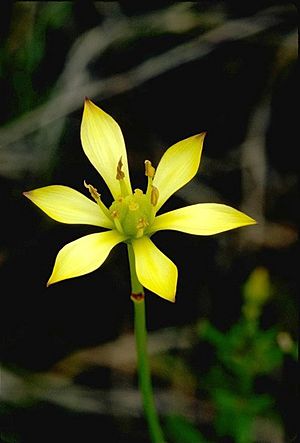Harper's beauty facts for kids
Quick facts for kids Harper's beauty |
|
|---|---|
 |
|
| Conservation status | |
| Scientific classification |
The Harperocallis flava, also called Harper's beauty, is a special wildflower. It grows only in certain parts of Florida in the United States. You can mostly find it in the Apalachicola National Forest. This plant is very rare and seriously endangered. It has been on the United States' endangered species list since 1979.
Contents
What is Harper's Beauty?
Harper's beauty is a type of plant that lives for many years. It grows from a special underground stem called a rhizome. This rhizome helps the plant spread. It has stiff, grass-like leaves that can grow up to 21 centimeters long.
Flowers and Pollination
This plant usually has one bright yellow flower on a tall, straight stalk. It blooms in April and May. The flower parts, called tepals, are about 1.5 centimeters long. After the plant makes fruit, these yellow tepals turn green.
Harper's beauty can fertilize itself. This means it doesn't always need another plant to make seeds. However, insects can also help with pollination. Tiny bees, especially halictid bees, often visit the flowers to help them spread pollen.
Where Does Harper's Beauty Live?
This plant naturally grows in wet, marshy areas called bogs or wet prairies. These places often have seeps, which are spots where water slowly comes out of the ground. The soil in these areas is usually sandy, acidic, and rich in peat.
The main tree in these habitats is often the longleaf pine (Pinus palustris). Harper's beauty is an important part of the longleaf pine ecosystem. This ecosystem used to have more buckwheat trees (Cliftonia monophylla) and pond pines (Pinus serotina).
The Importance of Wildfires
Wildfires are very important for the habitat of Harper's beauty. These natural fires help keep the area open. They clear away old trees, thick brush, and tall plants. This allows the Harper's beauty and other small plants to get plenty of sunlight. Fires also stop thick mats of grass from growing, which lets the wildflower take root.
Why is Harper's Beauty Endangered?
One of the biggest reasons Harper's beauty is becoming rare is because of fire suppression. This means people stop natural wildfires from happening. When fires are stopped, the habitat changes. The areas become overgrown, and the wildflower doesn't get enough sunlight.
Today, Harper's beauty sometimes grows best in places that are kept open by people. This can include roadsides or areas that are mowed. However, too much disturbance from cars or heavy machines can also destroy the plant populations.
Other Threats
There are other things that threaten Harper's beauty. Sometimes, people who admire wildflowers pick the blooms. This can harm the plant's ability to make seeds. Also, some plants are lost due to vandalism.
Scientists have studied the genes of Harper's beauty plants. They found that the species has very little genetic diversity. This means the plants are all very similar to each other. Low genetic diversity can make a species weaker and less able to survive new diseases or changes in its environment.
Protecting Harper's Beauty
When Harper's beauty was first studied in 1968, there were only a few groups of plants left. By 1979, there were fewer than 100 plants in total. Most of these were in the Apalachicola National Forest. The United States Forest Service works hard to protect this rare plant in those areas.
Since then, more groups of Harper's beauty have been found. In 2003, about 70 plants were discovered in Bay County. However, these plants are on private land and are not protected. In Liberty County, there are now many groups of plants, with an estimated total of over 8,000. Protecting these special wildflowers helps keep Florida's unique natural beauty alive.


